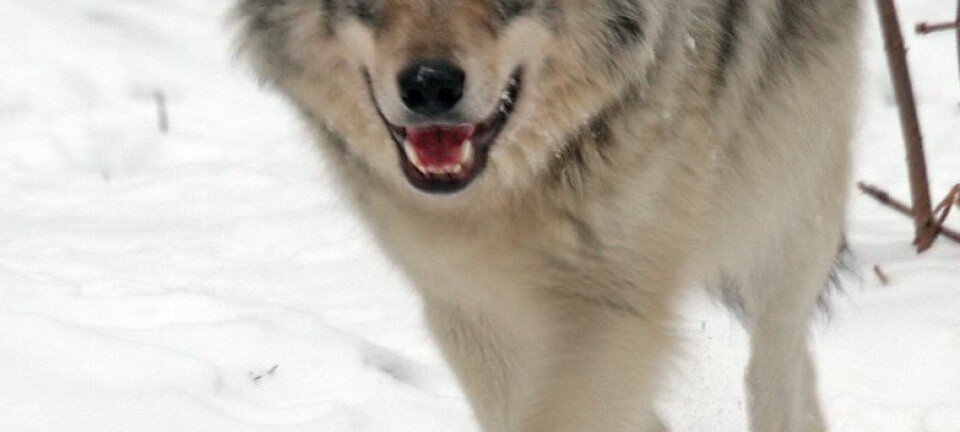
Wolves help support forest scavengers
Scavengers such as foxes, ravens and golden eagles get more year-round access to food supplies in wolf territories than in forests devoid of wolves.
Denne artikkelen er over ti år gammel og kan inneholde utdatert informasjon.
A Swedish study confirms that there is more food for scavengers in the spring in wolf territories, because wolves hunt year round. The study included wolves on the Norwegian side of the border.
“We think this is beneficial for a variety of species. Spring is a critical period when many species have insufficient food,” says Camilla Wikenros, a researcher at the Swedish University of Agricultural Sciences.
She points out that food supplies are more regular for animals such as martens, foxes and birds that live in wolf territories. Outside of these territories, food supplies peak in the autumn, when two-legged hunters shoot moose and leave some of the remains in the forest. There is less food for these scavengers during the rest of the year.
Wikenros led the new study, which was part of the research programme called SKANDULV.
Sixty cameras

The researchers mounted 49 cameras by the carcasses of moose that had been killed by wolves and 11 cameras by the remains of moose killed by hunters. The photos showed how often scavengers arrived on the scene and which species delved into the feasts.
The study is based on more than 15,000 pictures of different scavengers, including foxes, golden eagles, ravens, martens and Eurasian jays.
The researchers covered an area of 900 square kilometres in Sweden and part of Hedmark County in Norway.
“The number of moose killed by wolves annually is fairly regular. We have estimated how much food is available to scavengers outside wolf territory,” says Wikenros.

The wolf populations in Sweden and Norway have doubled in the past ten years, which Wikenros and fellow researchers think can help re-establish vital processes in the ecosystem.
“The remains of wolf-killed moose comprise a quarter of the annual available biomass for scavengers. The study shows that the wolf does not increase this total biomass, but it evens out the distribution across the year,” says Wikenros.
She stresses that this better seasonal spread enhances conditions for survivability among scavengers.
Hard to measure scavenger stocks
“Carcasses from wolf kills in the wilds will contribute to higher biodiversity, of course, simply because there’s more food available for more animals,” says Researcher Barbara Zimmermann of Hedmark University College (HiHm).
“Nevertheless, I don’t think we know enough about the development of scavenger stocks.”
She points out that there are hunting statistics on red foxes that show that the disease scabies has a big impact on fox stocks – probably much more of an impact than moose carcasses in wolf territories. But little is known about the ups and downs of these scavenger populations.
“For instance, the fact that gluttons [wolverines] have re-established themselves in forest areas at the same time as wolves might be coincidental. It’s too early to say whether gluttons have established themselves in wolf territories because wolves have stabilised the availability of food,” says Zimmermann.
There are currently no surveillance programmes for smaller species in the marten family, such as minks, ferrets and weasels. Zimmermann thinks this makes it harder to measure the effect of wolf-killed moose on the rises and falls of the different populations.
But a project has started at the HiHm campus at Evenstad to study martens and related animals as well as rodents.
Fewer red foxes in wolf territories
Petter Glorvigen looked into the importance of wolf-kill carcasses for red foxes in his master degree thesis at HiHm in 2008.
In a field study, 24 moose carcasses were placed around the woods as bait, both inside and outside wolf territories. Glorvigen concluded that fewer red foxes were consuming this biomass inside than outside wolf territories, simply because there were fewer foxes in the wolves' hunting grounds.
Glorvigen suggested that the increased annual supply of food could not compensate for a decrease in red foxes in wolf territory.
Even if there are uncertainties about how wolves affect the dynamics of scavenger populations, the Swedish study proves that scavengers feed on the leftovers from wolf kills. Wikenros wants to conduct further research on what effect this supply has on scavengers.
“We’ve applied for funding to take a closer look at the magnitude of these complexities, such as the size of fox stocks, and if they are affected so much that they actually increase,” says Wikenros.
--------------------
Read the Norwegian version of this article at forskning.no
Translated by: Glenn Ostling

































